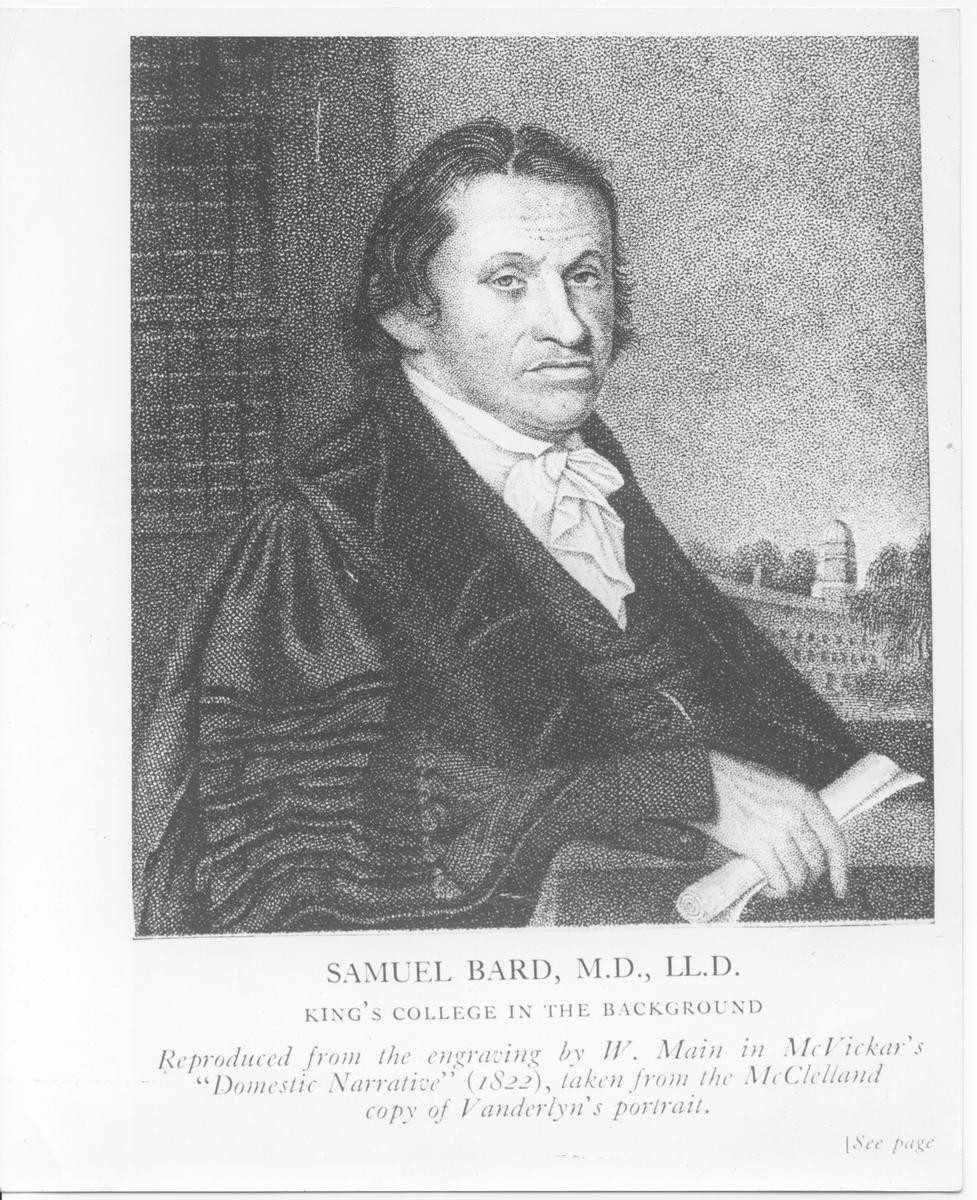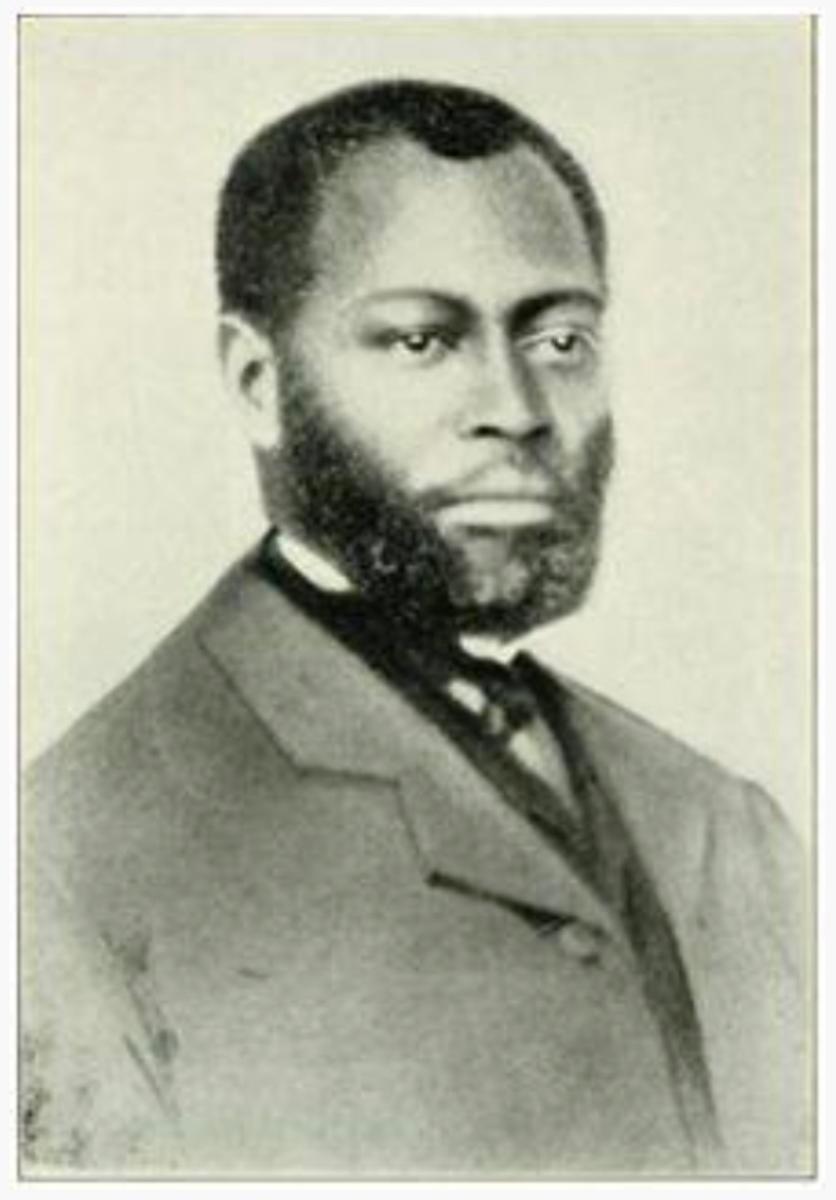Samuel Bard
Samuel Bard (1742-1821) enslaved at least eight people – and almost certainly more – during the course of his life and career as an early American physician. He coerced the labor of these people for domestic and agricultural work, and subjected them – living and dead – to study and experimentation to advance his professional standing.
With rural property in New Jersey and the Hudson Valley, as well as town homes in New York City, the Bard family utilized enslaved labor for a variety of purposes. The economic advantage of controlling the unpaid work of others allowed the Bards to prosper – sometimes in spite of the family’s own improvident business investments. Funds derived from enslavement often directly served Samuel Bard’s professional advancement. According to an early biographer of the Bard family, his medical education had been “an enormous financial burden for his father.”[1] In 1765, around the time that Samuel Bard returned from studying medicine in Edinburgh, his father, John Bard, was forced to lease some of his plantations in Dutchess County, New York, to a local overseer to cover the expenses. The contract included “the use of one negro woman named Jamaica, and a negro boy named Cuffy, and a negro girl named Prida.” It further specified that if any of these people should die during the term of the agreement they would be replaced, or the overseer would be reimbursed the value of their work.[2]
Runaway Slave Ad
In 1776, Samuel Bard paid to have a runaway-slave ad printed in a New York City newspaper in an attempt to capture and re-enslave a man named James, who had absconded from his household:
Run-away, a Negro Man named JAMES, tall and thin, the whites of his Eyes remarkably red, and his Face full of Eruptions: He is a talkative plausible Fellow, and had on when he went away an old grey Bearskin short Coat, Check Shirt, Linen Breeches, and worsted Stockings, and is supposed to be gone towards the East End of Long-Island. Whoever takes up and secures the said Negro, so that his Master may get him again, or brings him to Doctor Samuel Bard, in New-York, shall receive TEN DOLLARS Reward, and all reasonable Charges paid by SAMUEL BARD.[3]
This advertisement was published on July 8, 1776 – less than a week after the signing of the Declaration of Independence. In the coming conflict, members of the Bard family acted as Loyalists, their sympathies lay with the British in opposition to those fighting for American independence. It was perhaps an act of rebellion, therefore, on the part of Cuffy Bard, the enslaved child in the above-mentioned lease, that he decided to join the patriot cause and serve as a fife player in the Battle of Trenton.[4] After the war, the Bards embraced the new nation, and Samuel Bard served as personal physician to President George Washington – who at the time personally enslaved more than 100 people on his Virginia plantation[5] – during Washington’s time in New York City.
Census & Other Historic Evidence of the Bards as Enslavers
 Samuel Bard
Samuel Bard
The new U.S. Constitution stipulated the collection of a census every ten years, and these surveys provided some of the most detailed surviving information about the Bard family’s slaveholding. In the first census, taken in 1790, John Bard reported the presence of four enslaved people in his household. Samuel Bard’s household that year included three enslaved people. In 1800, Samuel Bard claimed seven enslaved people. In the 1810 census, Samuel Bard claimed eight enslaved people.[6] These snapshots offer some of the most reliable data on Bard family slave-owning, but they only provide data for the final few decades of Samuel Bard’s life, and even for those years are likely incomplete. These reported numbers, as an example, might have only reflected the number of enslaved people living in the Bards’ city homes, and not at their various country estates.[7]
The remaining evidence relating to the family’s importance as enslavers is fragmented and somewhat contradictory. On the one hand, several authors later in the nineteenth century spoke anecdotally of the Bards as extensive enslavers. “All my ancestors had held slaves,” Samuel Bard’s great-grandson wrote in a memoir. “There were a number of negroes owned by the family,” he continued. “They cut wood and kept the farm and did the out of doors work.”[8] Another author listed the Bards among “the largest slave owners” in their section of Dutchess County.[9] On the other hand, neither Samuel Bard’s nor John Bard’s wills listed enslaved people as part of their personal property. There are several likely explanations for this – John Bard was known to have been in financial difficulties at the end of his life, and it is possible as a result that he might have sold his slaves before his death – but in any case, the complete details of the total extent of the Bard family’s slaveholding remain to be fully discovered. A comprehensive reckoning with the family’s connections to enslavement would also need to consider the families of the Bards’ wives and relations, including the Crugers and Livingstons. These families ranked among the largest enslavers in the colonies – and also were prominently associated with King’s College and Columbia.
Enslaved Peoples' Roles in Bard's Professional Life
While Samuel Bard profited from the enslaved labor of others to satisfy his personal needs and amplify the family fortunes, he also used slave labor and the objectification of Black people as key elements in his professional life. For decades, Bard enslaved a man named Caesar who served as his valet and personal servant. Caesar’s presence conveyed prestige to his owner, enhancing his standing and professional dignity at such events as the granting of medical degrees. “On these occasions,” Bard’s great-grandson wrote in a family history, “he as usual was attended by his old body servant and faithful negro Caesar … when the audience had assembled, Caesar put on Dr. Bard’s shoulders the academic gown, and handed him his cocked hat, which the good doctor always wore before the audience, till the moment came for him to rise and say ‘ex autoritate’ etc. when he would remove his hat, and proceed with the stated form in Latin of conferring degrees.”[10]
In his medical writings, Bard used racially inscribed pseudo-knowledge to bolster his own claims of expertise. His most influential published work, Compendium on the Theory and Practice of Midwifery, included racialized stereotypes of Black people.[11] Among the avid readers of Bard’s text was at least one Southern enslaver eager to promote healthy – and profitable – births among enslaved people on his plantation.[12]
Horrific Research Methods
Of far more immediate concern to African Americans in eighteenth-century New York City – medical students and professors at the institutions with which Bard associated were notorious for stealing Black cadavers from local graveyards to use for anatomical dissections. Affiliated students and faculty from King’s College, the College of Physicians and Surgeons, and New York Hospital, all were implicated in this practice. And although Bard himself did not teach dissection – and no source yet discovered directly identified him as committing these thefts – his role as administrator of these institutions meant he would have approved of the macabre thievery committed by his faculty and students.[13]
Bard's Reputation as an Enslaver
 Portrait of Richard Jenkins
Portrait of Richard Jenkins
Samuel Bard benefited from the enslavement of others to the end of his life. In the first decades of the nineteenth century, shortly before his death, Bard apparently retained his hold on several enslaved people. This was a time when enslavement in New York State was decreasing rapidly; gradual emancipation laws meant that more and more people were winning their freedom. But Bard’s reputation as an enslaver was such that a committee of abolitionists found it necessary to personally visit his townhouse and interview a young slave named Pompey to confirm that he was not being held in bondage illegally.[14]
Richard Jenkins was another person known to have been enslaved by Bard in Dutchess County. Although records about his early life have not yet been discovered, local historians believe he was emancipated in the 1820s, perhaps after Bard’s death. Jenkins went on to serve with distinction as deacon at the Bard family church until the middle of the nineteenth century.
From the sources identified so far, we have learned of nine enslaved people owned by John and Samuel Bard. These are their names: Jamaica, Cuffy, Prida, Caesar, James, Jenny, Betsy, Pompey, and Richard Jenkins.
Reclaiming
Samuel Bard died in 1821. For decades, he was celebrated as a formative and praiseworthy figure in Columbia’s history. University president Nicholas Murray Butler would describe him as “a chief ornament” of the institution’s early years. So, it was a natural choice, when in 1931 – a century after his death – the trustees chose to name the new medical center dormitory “Bard Hall” in his honor.[15] The name was removed in 2020 at the urging of faculty and students.
*****
[1] Felix E. Hirsch, “Documents of a Great Columbia Family Are Now at Bard,” Columbia University Quarterly (October 1941): 25.
[2] Bard, John, “Lease of Land and negro servants to Lucas Lazier”, Oct. 8, 1765. BFPA 1-08-10. Bard Family Papers, Box 1, F. 8. Bard Archives and Special Collections.
[3] “Advertisement,” New-York Gazette, and Weekly Mercury, July 8, 1776.
[4] Silvia Dubois, who related her life story to a journalist more than a century later, identified Cuffy Bard as her father. C.W. Larison, Silvia Dubois (Now 116 Yers Old): A Biografy of the Slav who Whipt her Mistres and Gand Her Freedom. Ringos, NJ: C.W. Larison, Publisher, 1883, 44.
[5] “10 Facts about Washington and Slavery,” www.mountvernon.org.
[6] Census takers did not record the names of enslaved people. Thus, it is not possible to know how many of the seven people listed in Bard’s household in 1800 were also included in the figure of eight people noted for 1810.
[7] There is no known reference to the total number of enslaved people or servants employed on the Bard family’s Hudson Valley estate, but in later years Bard’s son, William’s household numbered about 16 domestic servants. Diary of Arthur Sandys, 66.
[8] Sandys, Arthur, Diary of Arthur Sandys, 118, 61.
[9] Edward Braman, “Anecdotes and Miscellaneous Information Chiefly Relating to Dutchess Co. and Especially to the Ancient Town of Clinton,” unpublished typescript, 1876: 40. Roosevelt, Franklin D., Hudson River Valley and Dutchess County Manuscript Collection, Franklin D. Roosevelt Library.
[10] Sandys, Arthur, Diary of Arthur Sandys, 53. According to Sandys’ memoir, Caesar had first been enslaved as an adolescent by Dr. John Bard in the 1740s and died at Hyde Park in the 1830s at an age of over 100 years old.
[11] Samuel Bard, A Compendium on the Theory and Practice of Midwifery (Collins and Company, 1819): 54.
[12] Marie Jenkins Schwartz, Birthing A Slave: Motherhood and Medicine in the Antebellum South (Harvard University Press, 2006): 362.
[13] Craig Steven Wilder, Ebony and Ivy: Race, Slavery, and the Troubled History of America’s Universities (Bloomsbury, 2014): 200-201.
[14] William Augustus McVickar, The Life of the Reverend John McVickar, S. T. D.: Professor of Moral and Intellectual Philosophy, Belles-Lettres, Political Economy, and the Evidences, in Columbia College (Hurd and Houghton, 1872), 30.
[15] “New Medical Dormitory, Harkness Gift, Rings Modern Note In Halls; Has Spacious Rooms, Squash Courts and Pool,” Columbia Spectator, September 29, 1931.